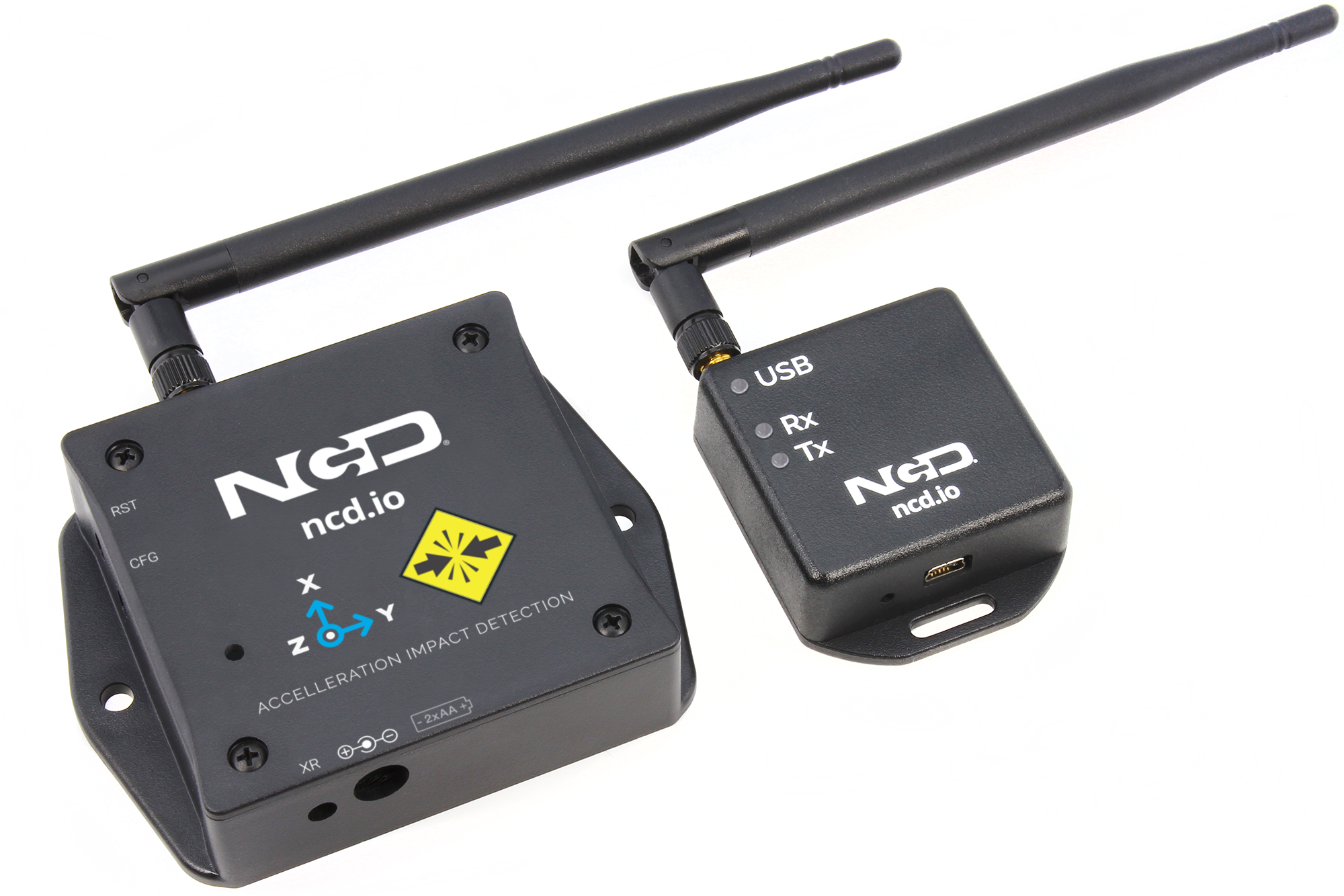IoT Long Range Wireless Acceleration and Impact Detection Sensor
Highlights
- Industrial Grade Impact Sensor with 3-Axis Accelerometer
- Configurable Impact Detection Parameters
- Uses Low-Power Interrupts for Impact Detection
- Sends up to 2 Extra Samples for Acceleration History
- Configurable Acceleration Range ±2g to ±16g
- Configurable Interrupt Threshold ±16mg to ±15.3g
- Configurable Data Rate 1Hz to 5.37KHz
- Configurable Interrupt Duration 200us to 1sec
- 2 Mile Line-of-Sight Range with On-Board Antenna
- Superior LOS Range of up to 28 Miles with High-Gain Antennas
- Interface to Raspberry Pi, Microsoft® Azure®, Losant, and More
- Example Software for Visual Studio and LabVIEW®
- Wireless Mesh Networking using DigiMesh®
- Open Communication Protocol for Easy Software Integration
- Small 3″ x 3″ Form Factor Wireless IoT Impact Sensor
- Power-Efficient Sleep Mode, Up to 10 Year Battery Life
- User Configurable Sleep duration
- Up to 300,000 Transmissions from 2 AA Batteries
- Includes Battery Level with Every Transmission
- Validates and Retries Lost Communication Packets
IoT Long Range Wireless Acceleration and Impact Detection Sensor
Introducing NCD’s Long Range IoT Wireless Impact Detection Sensor, boasting up to a 2 Mile range using a wireless mesh networking architecture. This device incorporates a precision acceleration sensor for measuring acceleration changes. Utilizing the interrupt feature of this sensor, it is able to minimize power consumption by waiting for the interrupt from the sensor.
Configure the Impact Detection condition (interrupt settings) using configuration mode. This impact detector offers many configuration parameters, including acceleration range, data rate, interrupt duration, and interrupt threshold. Interrupt duration is dependent upon data rate. It is the duration for which an interrupt condition has to hold to generate a system interrupt and initiate data transmission to a nearby receiver. Interrupt threshold is dependent upon acceleration range, and is the acceleration in g which (if exceeded) causes the interrupt to fire. Note the absolute value of actual g reading is compared, therefore it works for both positive and negative acceleration exceeding threshold.
Interrupts are fired only when the acceleration (absolute value) read form the sensor exceeds the threshold in the positive direction. All interrupts are combined with an OR gate. This allows impact detection (system interrupt) if an interrupt occurs for any axis (OR condition). User can also configure a delay time in seconds which disables the interrupt for that amount of time after a successful interrupt. This enables the user to make sure that the sensor does not drain its battery (with continuous transmissions) if an interrupt condition persists or a wrong condition is accidentally programmed. This time is also used to send a periodic packet to a receiver with latest available data.
The device also sends two extra samples with the sample which caused interrupt. This enables the user to have a history of acceleration data prior and after the interrupt. In a normal scenario, it will send 1 sample (n-1) prior to the interrupt sample (n) and 1 sample after the interrupt (n+1). However, if the data rate is too slow, the sensor does not wait for n+1 packet to arrive so as to save battery and instead sends 2 old samples (n-2, n-1) along with the third sample (n) which fired interrupt. It may happen that the duration and sleep delay combination is such that no old sample was saved after the last interrupt and at the time of interrupt the device may contain only 1 sample. In that case it sends 2 old samples from the last transmission along with third sample (n) being the interrupt sample. In case it has 1 old sample (n-1) and 1 interrupt sample (n), it will send the first sample (n-2) from the previously transmitted data.
Powered by just 2 AA batteries and an operational lifetime of 300,000 wireless transmissions, a 10 years battery life can be expected depending on environmental conditions and the data transmission interval. Optionally, this sensor may be externally powered.
The long range, price, accuracy, battery life and security features of Wireless Impact Detection Sensor makes it an affordable choice which exceeds the requirements for most of the industrial as well as consumer market applications.
NOTE: The current version of this sensor does not support the inbuilt temperature sensor.
Transmission Interval
This device sends data when input thresholds exceed user-defined preset limits.

Impact Detection Sensor Applications
- Wireless Impact Detection
- Machine Health Monitoring
- Ideal Component for Predicative Maintenance
- Abnormal Vibration Detection
- Acceleration and Impact Monitoring for AWS® and Azure®
Full Node-RED Support
Use the power of Node-RED to quickly create complex logic flows and temperature alerts without a single line of code!

Mechanical Drawing

Wiring Diagrams
Essential
Examples
Documentation Downloads
Community Repositories
Enterprise 868 MHz Sensors
Enterprise 900MHz Sensors
Not for use in outdoor applications or for use in excessive temperature conditions. Prolonged freezing will prevent batteries from functioning until thawed, using extended temperature range industrial batteries may improve the useful temperature range. Extended freezing applications should use a full-time powered solution. Prolonged exposure to extreme humidity conditions may damage this device. The sensing element is rated for use for 5 years and may be replaced. Exposure to high temperatures may cause the batteries to leak, causing permanent damage to this device. NCD Warranty does not cover battery corrosion or use in excessively smoky environments under any circumstances.
900HP-S3B Wireless Compatibility Notes
Notice: Compatibility Notes Does NOT Apply to the Following Products:
- NCD Enterprise Solutions
- NCD Wireless Sensors
- NCD Enterprise Modems and Gateways
Notice: Compatibility Notes Applies to NCD Industrial Products, Including Fusion, ProXR, ProXR Lite, Taralist, and Reactor Series Products.
Compatibility Notes
When using an 900HP-S3B communication module, it is essential that you use the ZIGMO_PCB to configure the module settings. Long-Range wireless sensors may be programmed over the air without removing the communications module.
A 900HP-S3B Modem or a gateway of some kind that support the 900HP-S3B communications module will also be required.



